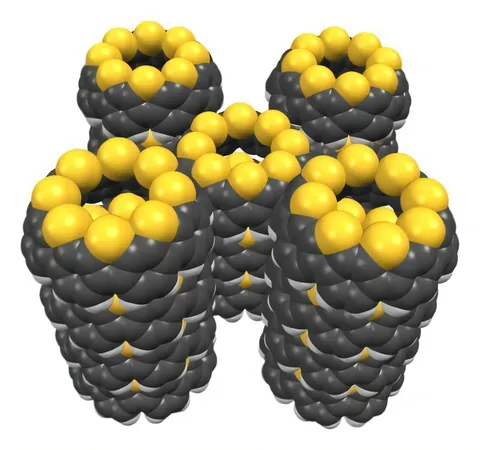
Revolutionary Sulfur-Capped Carbon Nanobelts Set to Transform Optoelectronics
2025-05-09
Author: Amelia
A Breakthrough in Nanotechnology
Researchers at RIKEN have unveiled an exciting and straightforward method to fuse carbon nanobelts with sulfur-containing compounds, a monumental leap that could reshape the future of optoelectronic devices. Their findings, published in Nature Communications, are capturing the attention of the scientific community.
Harnessing the Power of Carbon Nanobelts
Since carbon nanotubes burst onto the scene in 1991, their remarkable potential has led to applications across various fields, including electronics and medicine. Carbon nanobelts, essentially cross-sectional slices of these nanotubes, are being eyed for their versatility in electronic and optoelectronic devices.
A Historic Synthesis
Though attempts to synthesize carbon nanobelts date back to the 1950s, it wasn’t until 2017 that a team led by Kenichiro Itami succeeded. This breakthrough ignited a wave of research, with scientists globally eager to explore the potential of these remarkable structures. Itami states, "People realized that it's not a dream molecule; it is possible to synthesize it." Now, various research groups are experimenting with diverse forms of nanobelts.
Innovative Merging with Thiophene
In their latest work, Itami and his team successfully merged carbon nanobelts with thiophene, a unique compound consisting of a sulfur atom bonded to four carbon atoms. This combination is particularly exciting due to thiophene's rich functional properties, including impressive semiconducting and fluorescent capabilities.
Surprising Simplicity of the Reaction
The synthesis of the thiophene-fused nanobelts proved to be startlingly simple. Itami expressed his astonishment, noting, "It's just a single-shot reaction." The idea originated from Hiroki Shudo, a team member who proposed the synthesis after being inspired by literature. To everyone's surprise, the reaction worked seamlessly, catching even Itami off guard.
Unexpected Properties Unveiled
The researchers observed an intriguing phenomenon: the alignment of nanobelts varied based on the surface—sulfur sides up on copper and down on gold. Itami remarked, "That was really unexpected. We're now seeking to understand why it happens." This could open pathways to new applications in materials science.
The Future of Optoelectronics Is Here
The implications of these thiophene-fused nanobelts extend far beyond mere academic interest. They hold promising potential for the next generation of optoelectronic devices and polar materials. Itami noted the enthusiastic interest from international research groups looking to collaborate, stating, "Several research groups in other countries are extremely excited about using our molecule in devices." They are currently distributing samples to kick-start these global partnerships.
Endless Possibilities Ahead
With the innovative synthesis strategy now established, Itami and his team are excited to explore what other molecular varieties can be crafted from this technique. The future looks bright for carbon nanobelts, as these cutting-edge materials are set to carve out a significant niche in technology and beyond.









 Brasil (PT)
Brasil (PT)
 Canada (EN)
Canada (EN)
 Chile (ES)
Chile (ES)
 Česko (CS)
Česko (CS)
 대한민국 (KO)
대한민국 (KO)
 España (ES)
España (ES)
 France (FR)
France (FR)
 Hong Kong (EN)
Hong Kong (EN)
 Italia (IT)
Italia (IT)
 日本 (JA)
日本 (JA)
 Magyarország (HU)
Magyarország (HU)
 Norge (NO)
Norge (NO)
 Polska (PL)
Polska (PL)
 Schweiz (DE)
Schweiz (DE)
 Singapore (EN)
Singapore (EN)
 Sverige (SV)
Sverige (SV)
 Suomi (FI)
Suomi (FI)
 Türkiye (TR)
Türkiye (TR)
 الإمارات العربية المتحدة (AR)
الإمارات العربية المتحدة (AR)